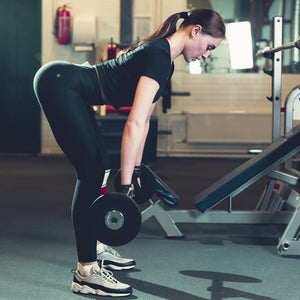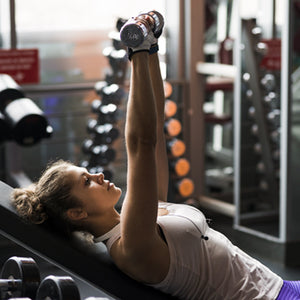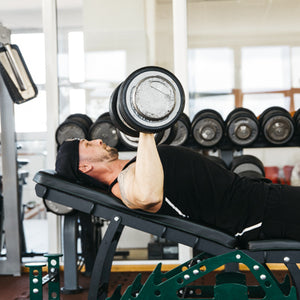FREE SHIPPING International Orders $275+

Advanced Bicep Training - 5 Alternative Bicep Exercises
I have a confession to make: I hate biceps training. Why? Because all you can really do in your biceps training is curl, curl and then curl some more.
it's boring, monotonous and sometimes seen as useless. But as one with the bodybuilding/physique-building mindset it's still an integral part of creating symmetry and balance and the fact that you can fill out your sleeves. So, I must swallow the bitter biceps pill and drive forward.
Related: 7 Big Bicep Workout Tips
So, with that said, I?ve had to delve deep into my bag-o-tricks and try to come up with a few new twists on the ole curl or I risk getting a visit from the men in white coats. The list of angles, functions and interesting exercises seems endless for training chest, back, legs and even shoulders, but biceps requires a little (or a lot) more creativity.
Below are 5 alternative biceps exercise with hopes of bringing a little more interest to the otherwise same-ole, boring and tired curl-fest. Yes, you will still have to curl in some way, shape or form but why not try to make it a little more fun along the way. All you have to gain is bigger arms in the process.

Since your range of motion is limited it will also allow you to use more weight than when performing the standing version. Finally, since you are mainly working your biceps in the top half of the movement you will achieve an intense biceps contraction with all that weight.
The how: Sit at the end of a bench and lock your hips and upper body into an upright position. Place a straight barbell or EZ bar on your lap and grasp it with an underhand grip. With your elbows by your sides curl the weight up toward your chest for a peak contraction before lowering the weight back down.
Now, you can either not allow the weight to touch your legs in the bottom position to take advantage of constant tension or you can rest the bar briefly rest/pause style in order to load more weight on the bar. Whatever you decide try to avoid the temptation to lean back too much during the lift.
The great thing is the stress applied is unique and will also affect other areas such as the lats, forearms and abs. Used as a main exercise or a finisher, chins will torch your biceps.
The how: Grasp an overhead straight bar with an underhand grip about the same width as your shoulders. Here?s the key: When you begin pulling your body up make sure you round your back so most of the stress is placed on your biceps.
With a traditional pull-up you will normally try to arch your back to focus on your lats, but with biceps chin-ups you want your lats out of the movement as much as possible. Also, as you pull up leave your shoulder girdle up and try not to contract it down. Instead, focus on your arms pulling you up.
You may need to lighten the load and try a new way to stimulate growth, namely by making your biceps work harder without adding more weight. Enter the single-arm barbell curl. This will challenge your strength, balance and patience (in a good way).
The how: There are two main ways to perform this exercise. You can either simply stand or you can utilize a preacher bench. Either way, the execution is the same. Grasp a light preformed barbell in the middle with one hand. Slowly curl the weight up as if you were performing a dumbbell curl.
You will immediately feel your arm fighting to keep the weight balanced. This struggle will make your biceps and surrounding supportive muscles work harder than ever before. Once you are in the top position slowly lower the weight under complete control to the fully stretched position. You will have to go light at first to adapt and find the right balance.
As another bodyweight exercise not utilizing the traditional curl the suspension trainer curl will test your true strength and give you an insane pump. For those of you who don't have access to a TRX or other suspension trainer this can easily be modified with a bar set at about hip level in a squat rack, power rack or Smith machine.
The how: Set up a suspension trainer system, face where the trainer originates and grip the handles. Place your feet a few feet from the attachment point and form a straight line with your body. The angle will all depend on your skill and strength but you can start with your arms straight out perpendicular from your body and your body at about a 45 degree angle with the floor.
Without moving your upper arms curl your arms by brining your hands towards your face. Feel an intense contraction before returning to the starting position. You can easily perform the same exercise under a fixed bar by simply curling up to the bar.
Hoisting a kettlebell during a curl (and in a certain way) can breathe new life into your arm training. But you?re not going to simple curl up the kettlebell. The top position would allow for too much rest on the biceps. There is a simple trick.
The how: Grab a pair of kettlebells with a neutral grip (thumbs forward). As you start to perform a supinated curl (twisting your hands as you curl) keep the weight close to your sides as if you were performing drag curls. This is achieved by pointing your elbows back behind you as you curl.
Why? So you can keep the tension on the biceps all the way to the top of the movement. Reverse the exercise and bring the weight back down. The kettlebells should be moving in a straight line up and down instead of an arching motion.
it's boring, monotonous and sometimes seen as useless. But as one with the bodybuilding/physique-building mindset it's still an integral part of creating symmetry and balance and the fact that you can fill out your sleeves. So, I must swallow the bitter biceps pill and drive forward.
Related: 7 Big Bicep Workout Tips
So, with that said, I?ve had to delve deep into my bag-o-tricks and try to come up with a few new twists on the ole curl or I risk getting a visit from the men in white coats. The list of angles, functions and interesting exercises seems endless for training chest, back, legs and even shoulders, but biceps requires a little (or a lot) more creativity.
Below are 5 alternative biceps exercise with hopes of bringing a little more interest to the otherwise same-ole, boring and tired curl-fest. Yes, you will still have to curl in some way, shape or form but why not try to make it a little more fun along the way. All you have to gain is bigger arms in the process.

5 Bicep Exercises for Advanced Gains
#1 - Seated Barbell Curl
There's a good chance you've either heard of this one or have seen it done in the gym and thought to yourself, ?what the heck is that dude doing?!? Performing barbell curls in a seated position has several advantages. It restricts your execution forcing you to use near perfect form ? you can't swing and sway the weight up.Since your range of motion is limited it will also allow you to use more weight than when performing the standing version. Finally, since you are mainly working your biceps in the top half of the movement you will achieve an intense biceps contraction with all that weight.
The how: Sit at the end of a bench and lock your hips and upper body into an upright position. Place a straight barbell or EZ bar on your lap and grasp it with an underhand grip. With your elbows by your sides curl the weight up toward your chest for a peak contraction before lowering the weight back down.
Now, you can either not allow the weight to touch your legs in the bottom position to take advantage of constant tension or you can rest the bar briefly rest/pause style in order to load more weight on the bar. Whatever you decide try to avoid the temptation to lean back too much during the lift.
#2 - Reverse-Grip Chin-Up
Here is yet another non-traditional biceps builder that you may have seen or read about over the last few years. Taking advantage of bodyweight training, the reverse-grip chin-up done specifically to stress the biceps allows you to stimulate arm growth without actually performing an arm curl.The great thing is the stress applied is unique and will also affect other areas such as the lats, forearms and abs. Used as a main exercise or a finisher, chins will torch your biceps.
The how: Grasp an overhead straight bar with an underhand grip about the same width as your shoulders. Here?s the key: When you begin pulling your body up make sure you round your back so most of the stress is placed on your biceps.
With a traditional pull-up you will normally try to arch your back to focus on your lats, but with biceps chin-ups you want your lats out of the movement as much as possible. Also, as you pull up leave your shoulder girdle up and try not to contract it down. Instead, focus on your arms pulling you up.
#3 - Single-Arm Barbell Curl
You may think the only way to progress in your biceps training is to add more weight to the basics such as barbell and dumbbell curls. Lift heavier, get bigger. Sometimes this doesn't work. Are your biceps still the same size and shape they were 6 months ago? A year ago?You may need to lighten the load and try a new way to stimulate growth, namely by making your biceps work harder without adding more weight. Enter the single-arm barbell curl. This will challenge your strength, balance and patience (in a good way).
The how: There are two main ways to perform this exercise. You can either simply stand or you can utilize a preacher bench. Either way, the execution is the same. Grasp a light preformed barbell in the middle with one hand. Slowly curl the weight up as if you were performing a dumbbell curl.
You will immediately feel your arm fighting to keep the weight balanced. This struggle will make your biceps and surrounding supportive muscles work harder than ever before. Once you are in the top position slowly lower the weight under complete control to the fully stretched position. You will have to go light at first to adapt and find the right balance.
#4 - TRX or Rack Curl
The advantages of the TRX trainer (or any other suspension trainer) are endless. Allowing you to move your bodyweight training far beyond just push-ups and sit-ups the TRX can be used to isolate and fry your biceps as well.As another bodyweight exercise not utilizing the traditional curl the suspension trainer curl will test your true strength and give you an insane pump. For those of you who don't have access to a TRX or other suspension trainer this can easily be modified with a bar set at about hip level in a squat rack, power rack or Smith machine.
The how: Set up a suspension trainer system, face where the trainer originates and grip the handles. Place your feet a few feet from the attachment point and form a straight line with your body. The angle will all depend on your skill and strength but you can start with your arms straight out perpendicular from your body and your body at about a 45 degree angle with the floor.
Without moving your upper arms curl your arms by brining your hands towards your face. Feel an intense contraction before returning to the starting position. You can easily perform the same exercise under a fixed bar by simply curling up to the bar.
#5 - Kettlebell Curl
The timeless, archaic Kettlebell is another tool that seems to be here to stay, and for good reason. Providing a unique stimulus with an unbalanced load, they can make any normal, traditional lift more demanding. Applying these principles to biceps training is no different.Hoisting a kettlebell during a curl (and in a certain way) can breathe new life into your arm training. But you?re not going to simple curl up the kettlebell. The top position would allow for too much rest on the biceps. There is a simple trick.
The how: Grab a pair of kettlebells with a neutral grip (thumbs forward). As you start to perform a supinated curl (twisting your hands as you curl) keep the weight close to your sides as if you were performing drag curls. This is achieved by pointing your elbows back behind you as you curl.
Why? So you can keep the tension on the biceps all the way to the top of the movement. Reverse the exercise and bring the weight back down. The kettlebells should be moving in a straight line up and down instead of an arching motion.






